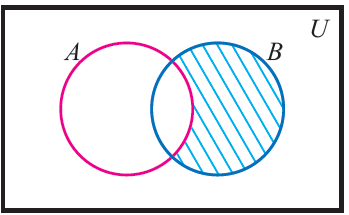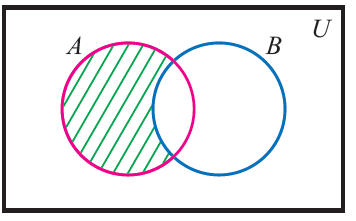VENN DIAGRAM OF B DIFFERENCE A
Here we are going to see how to draw a venn diagram of B difference A.
Venn diagram of B difference A :
B\A (or) B - A
To draw a venn diagram for B\A, shade the region of B by excluding the common region of B and A.
B\A (or) B - A

Let A and B be two sets.
Now, we can define the following new set.
B \ A = {z | z ∈ B but z ∉ A}
(That is z must be in B and must not be in A)
B \ A is read as "B difference A"
Now that B \ A contains only elements of B which are not in A and the figure given above illustrates this.
Venn diagram of A difference B :
A\B (or) A - B
To draw a venn diagram for A\B, shade the region of A by excluding the common region of A and B.
A\B (or) A - B

Let A and B be two sets.
Now, we can define the following new set.
A \ B = {z | z ∈ A but z ∉ B}
(That is z must be in A and must not be in B)
A \ B is read as "A difference B"
Now that A \ B contains only elements of A which are not in B and the figure given above illustrates this.
Let us look into some examples to understand the above concepts.
Example 1 :
If A = {- 2, - 1,0,3,4}, B = {- 1,3,5}, find (i) A - B (ii) B - A
Solution :
A = {- 2, - 1,0,3,4} and B = {- 1,3,5}
A - B = { -2, 0, 4}
B - A = { 5 }
Example 2 :
If A = {2, 3, 5, 7, 11} and B = {5, 7, 9, 11, 13} , find A Δ B.
Solution :
A = {2, 3, 5, 7, 11} and B = {5, 7, 9, 11, 13}
A - B = { 2, 3 }
B - A = { 9, 13 }
A Δ B = (A - B) U (B - A)
= { 2, 3, 9, 13 }
Example 3 :
Given that U = {3, 7, 9, 11, 15, 17, 18}, M = {3, 7, 9, 11} and N = {7, 11, 15, 17},
find (i) M - N (ii) N - M (iii) N' - M (iv) M' - N
(v) M n (M - N) (vi) N U (N - M) (vii) n(M - N)
Solution :
U = { 3, 7, 9, 11, 15, 17, 18 }
M = { 3, 7, 9, 11 }
N = { 7, 11, 15, 17 }
(i) M - N
The set M - N would contain the elements of the set M excluding the elements of M n N
M - N = { 3, 9 }
(ii) N - M
The set N - M would contain the elements of the set M excluding the elements of N n M
N - M = { 15, 17 }
(iii) N' - M
N' = { 3, 9, 18 }
N' - M = {18}
(iv) M' - N
M' = { 15, 17, 18 }
M' - N = { 18 }
(v) M n (M - N)
The set M n (M - N) would contain the set of common elements that we found in both the set M and (M - N)
M = { 3, 7, 9, 11 } M - N = { 3, 9 }
M n (M - N) = { 3, 9}
(vi) N U (N - M)
N = { 7, 11, 15, 17 } N - M = { 15, 17 }
N U (N - M) = { 7, 11, 15, 17 }
(vii) n(M - N)
Number of elements of set M - N is 2.
Hence n(M - N) = 2
Related topics
- Venn diagram A U B
- Venn diagram A n B
- Venn diagram of A'
- Venn diagram of B'
- Venn diagram of (AUB)'
- Venn diagram of (AnB)'
- Venn diagram of A\B
- Venn diagram of B\A
Kindly mail your feedback to v4formath@gmail.com
We always appreciate your feedback.
©All rights reserved. onlinemath4all.com
Recent Articles
-
10 Hard SAT Math Questions (Part - 34)
Nov 15, 25 08:00 AM
10 Hard SAT Math Questions (Part - 34) -
Algebra Word Problems Worksheet with Answers
Nov 10, 25 06:30 PM
Algebra Word Problems Worksheet with Answers -
Tricky SAT Math Problems Solved Easily
Nov 09, 25 07:02 PM
Tricky SAT Math Problems Solved Easily


